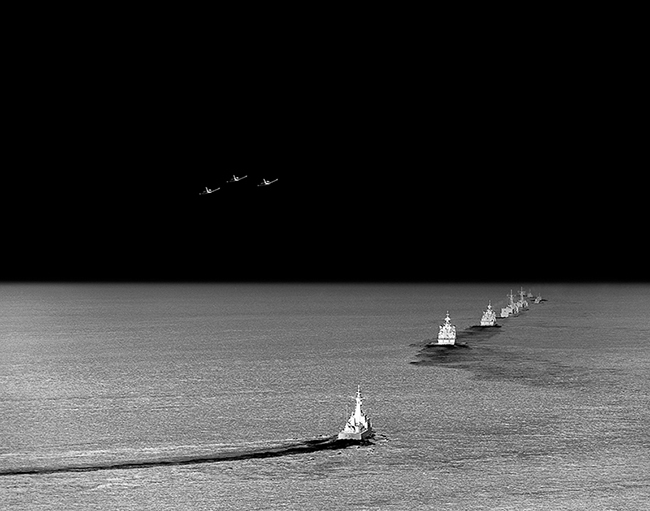The Sea is my Land
Curated by Francesco Bonami & Emanuela Mazzonis
MAXXI, Rome, Italy
3.07.2013 - 29.09.2013
Opening 03.07.2013
Catalogue: Giangiacomo Feltrinelli Editore (2013)
Ammar Abd Rabbo, Yuri Ancarani, Taysir Batniji, Mohamed Bourouissa, Marie Bovo, Aleš Bravnicar, Stéphane Couturier, Fouad Elkoury, Mounir Fatmi, Dor Guez, Adelita Husni-Bey, Mouna Karray, Panos Kokkinias, Irena Lagator Pejovic, David Maljkovic, Mark Mangion, Mladen Miljanovic, Moataz Nasr, Adrian Paci, Christodoulos Panayiotou, Agnès Roux, Arslan Sukan
A thousand things together. Not one landscape, but countless landscapes. Not one sea, but a progression of seas. Not one civilisation, but a series of civilisations piled one on top of the other.”
Fernand Braudel
The Mediterranean: 46,000 km of coastline linking twelve inland seas, the three continents of Europe, Asia and Africa, and two cultural hemispheres – east and west. As well as being a geographical entity, the Mediterranean Sea is a crossroads for peoples, cultures, religions, languages and political and economic systems. Its coasts are a point of encounter between civilisations that are constantly coming together or moving apart, communicating or clashing, forging relations that are not always peaceful. This area was the cradle for the world’s most ancient cultures: Western Christian, Greek-Slavonic, Jewish, Arab and Egyptian, and its coasts are dotted with historic cities that played a key role in economics, commerce and culture: Barcelona, Seville, Venice, Genoa, Istanbul, Marseilles, Tunis and Alexandria. This basin is home to the world’s richest artistic heritage, from archaeological sites to the cities of art of the past and future, that continue to bear witness to urban and cultural transformations. The migration flows that since time immemorial have invaded and crossed the area from north to south, east to west, mingle the many racial identities present in these areas and give rise to encounters that can lead to new understandings, or discord and tensions, forging new social and cultural trajectories. Unfortunately these encounters often run the risk of turning into civil conflicts and generating interminable political clashes. This basin of social, economic, political and cultural revolutions spawns radical, ongoing transformations that continue to reflect the complexity of cultural integration between different peoples. In this milieu of constant change, the Mediterranean is also an arena for cultural dialogue, where the impartiality of art has the power to overcome social barriers, religious pluralism and ethnic dispersion, and foster peaceful communication among those concerned. The exhibition The Sea is My Land came about with these ideas in mind, bringing together 22 artists from the 22 countries that are bordered by the Mediterranean Sea: Spain, France, Monaco, Italy, Malta, Slovenia, Croatia, Bosnia and Herzegovina, Montenegro, Albania, Greece, Cyprus, Turkey, Syria, Lebanon, Israel, Palestine, Egypt, Libya, Tunisia, Algeria and Morocco. The aim is to foster dialogue between arts, countries and people, exploring the distances and relationships between different geographical areas. The exhibition looks to photography and video to reveal the ongoing interactions between these numerous nationalities: the works reveal how artists originally from one country migrate elsewhere to study, analyse and narrate events going on in countries similar or different to their own. The works go beyond political and geographical confines, as the artists grapple with critical situations to reflect on local identities and the changes wrought by every revolution. As the etymological origin of the word Mediterranean shows – medius, ‘middle, between’ + terra, ‘land, earth’ – this area is a crucial intersection that lies at the heart of complex social and cultural mechanisms, multiple ideologies, singular affinities and heterogeneous harmonies: forces that make it an enduring source of inspiration for art.
Braudel, Fernand, La Méditerranée, Flammarion, Paris, 1985
